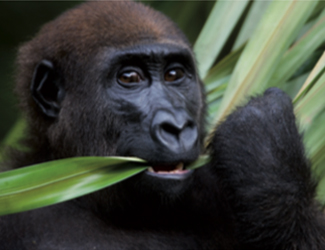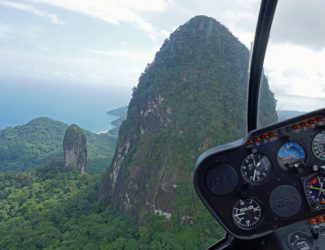Max Planck Institute
In 2005, the Max Planck Institute of Evolutionary Anthropology in collaboration with Africa’s Eden, initiated a project for habituating wild lowland gorillas and chimpanzees within Loango National Park for the joint purposes of ecotourism and research.
Under the direction of Professor Christophe Boesch and Dr Martha Robbins, a team of researchers and ecoguides began the slow process of habituating these great apes with two objectives.
Objectives
The first objective is to begin a scientific study of the sympatric populations of gorillas and chimpanzees that live side by side within the park. During the habituation process, emphasis is placed on differences in feeding ecology and habitat use between the two ape species. The researchers of Max Planck Institute (MPI) are also interested in differences in social behavior and grouping patterns between the two species and among other populations of apes in Africa.
The second objective is to habituate two groups of gorillas and one community of chimpanzees for ecotourism purposes, allowing visitors the opportunity to see these animals in their natural environment.
Research Team of the Max Planck Institute
The team includes 3 expatriate researchers, 3 ecoguides and 8 pygmy trackers. The trackers are a vital part of the gorilla habituation process, as they have the skills to follow the trail of gorillas in places where no signs are visible to most human eyes.
Number of gorillas and chimps in Loango
The research team of the Max Planck Institute estimates that there are 8 groups of gorillas and 3 communities of chimpanzees within this zone. Recent efforts have focused on 2 large groups of gorillas near the lagoon and a healthy sized community of chimpanzees closer to the ocean.
Great progress in 3 years time
Max Planck Institute is already three years into the study and great progress has been made with both ape species. Two research camps have now been set up some 10km apart (see below: higher density of gorillas in Yatouga area), one bordering the ocean and the other bordering the large Iguela lagoon.
The study site comprises the 80km² area between and around these two camps, which includes primary and secondary forest; swamp and savannah.
Study on food availability
In parallel with the habituation project, the MPI team has been conducting a study of food availability, specifically phenology studies (variation in fruiting patterns) and studies of vegetation transects on tree and plant studies eaten by the gorillas and chimpanzees:
9080 trees were measured in the vegetation study and 170 different species identified.
For the phenology study, 483 trees from 50 species are monitored on a monthly basis for presence of fruit / flowers / new leaves.
This allows researchers to gain a better understanding of the availability and abundance of fruiting species, and thus assists them in predicting the movements of the apes in relation to the current distribution of resources.
Gorilla habituation
Higher density of gorillas in the Yatouga area
In June 2007, the Max Planck Institute together with Africa’s Eden set up a second research camp (Yatouga) beside the Iguela lagoon approximately 9 km northeast of our original camp site (Ozouga). The team explored this area and found there to be a much higher density of gorillas using the forest here than along the coast. Since the construction of this camp, the frequency of gorilla contacts has increased significantly.
Increase in gorilla contacts
An increase in contacts has brought about a change in the behaviour of the gorillas towards the researchers.
Whilst the females and juveniles are still shy of being visible to observers, the silverback frequently stays at close proximity (30-40 m away) for prolonged periods of time. The researchers advance until the silverback barks to warn them that they are too close, at which point they stop and remain motionless for 10 minutes.
The Max Planck researchers then begin the advancing process again until the male barks and so it continues. The rationale is that this allows the gorillas to understand that the researchers respect the distance at which they are comfortable in the presence of the researchers and trackers, and it should result in a quicker increase in their level of trust for humans.
The gorillas have also stopped fleeing for long distances following a contact with the MPI reseachers. When they decide to leave a contact, often they will only move 100-200m away before stopping to feed again. This is a very important step in the habituation process, as it is evidence of an increased acceptance of human presence.
Habituating gorillas is a slow process of gaining their trust and acceptance of humans at close proximity. We anticipate that it will take another 2-3 years before the group is habituated fully and tourism can begin.
Chimpanzee habituation
Chimpanzee habituation is very different from gorilla habituation, as chimpanzees do not leave enough trail signs for systematic tracking to be a possibility because they weigh less.
Fission-fusion community
Chimpanzees have a fission-fusion community structure, which means that they are not in constant contact with one another and often forage in small parties or even alone.
In order to keep abreast of the movements of the rest of the community (who may be over 1km away), chimpanzees use loud vocalisations and drumming on large tree buttresses as a means of communicating with the other members of their group. They are most vocal early in the morning and late in the afternoon, and researchers are able to take advantage of this fact for contacting them.
Vocalisation amongst chimps
During the day they also frequently vocalise for many reasons:
- the arrival of another member of the community into a feeding party
- excitement at the discovery of a heavily fruiting tree
- a dispute between 2 or more individuals over females, food, or dominance
Vocalisations are advantageous for the researchers because they allow researchers to sit quietly in an area of the forest where chimpanzees were seen the day before and wait for them to vocalise.
While chimpanzee habituation is a slow process the project continues to make significant advances, and the Max Planck Institute hopes that in two to three years these apes may be comfortable enough with human presence to allow the first visitors into their special world.




Other conservation projects
In addition to the conservation activities together with our partners: Max Planck Institute and the Fernan-Vaz Gorilla Project, Africa’s Eden also supports individuals researchers, mostly in terms of on-the-ground logistical support and accommodation. Below a few examples of supported research by Africa’s Eden.
Tours
Africa’s Eden offers several attractive tours in Gabon and Príncipe. From just a weekend in Loango or Roça Belo Monte, up to 13 days combination tour Gabon-Príncipe. Read more
Forever Príncipe
Forever Príncipe conservation alliance is part of the Conservation Tourism Programme on the island of Príncipe in the Gulf of Guinea developed by Africa’s Eden. Read more




